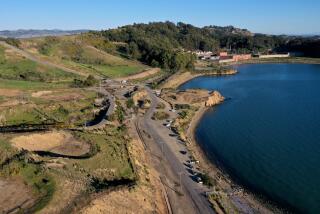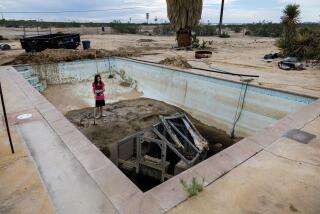Flooding Doesn’t Slow Plans to Build on Riverbed
- Share via
FRESNO — Of all the debates uncorked by the floods of 1997, the most peculiar just might be the one taking place between the gentle bluffs of the San Joaquin River.
No major river in America, not even the Colorado, has seen more of its flow choked off by man. About 98% of the water crashing down the upper San Joaquin never makes it here because it is shoved by a network of dams and canals to distant farms. The trickle has allowed this city and two counties along the San Joaquin to take a step that other flooded communities might consider great folly--allowing builders to put houses right smack in the river bottom.
Plans to build two golf courses and several hundred houses and condominiums there are fast moving forward, even though most of the land was under water last week from a river that raged back to life, if only for a few days.
“This isn’t the bluffs we’re talking about. This isn’t the banks of the river. They want to build in the river bottom,” said Fresno attorney Bob Rosati. “It doesn’t take a genius to figure out that this is the last place for houses, roads and sewer plants.”
Rosati is trying to mount a last-minute legal challenge to the first subdivision in Fresno’s portion of the river: an exclusive housing tract for the horsy set tucked between two golf courses on the river bottom.
The project belongs to developer Jon Thomason and a few days ago, at the spot where he helped rescue 10 horses from rising flood waters, Thomason stood on a saturated earthen building pad and laid out his notion of suburban utopia.
“I look at this as my dream location,” said the 29-year-old developer. “Do you hear any urban noise down here? Do you see any traffic? Do you think I’ll need to lock the doors?”
In the distance, a family of red foxes emerged from their burrow. “If we’re not going to allow houses down here, should we get rid of the fox dens, too?” he asked. “I guess people are so stupid that we can’t allow them to exercise their free rein, but we’ll allow animals of a lesser intelligence to exercise theirs.”
*
Opponents of river bottom development say it threatens not only a treasured riparian habitat that stands out against the harsh backdrop of this farming and urban flatland, but also runs counter to a planned San Joaquin River Parkway with trails and picnic tables along the river’s 22-mile serpentine course from Friant Dam to California 99.
“As soon as you introduce development, you change the look of the land, you scare off the wildlife and affect the flood flows,” said Steve Jacoby, vice president of the San Joaquin River Parkway Trust. “You can’t have it both ways.”
But developers and some of the politicians who support them argue that houses can be built on the river bottom without subverting the parkway or putting nature and future homeowners in harm’s way. That was the case at a meeting last week on Fresno’s new general plan for development, when Councilman Mike Briggs was asked about the suitability of building hundreds of houses on the river bottom.
His meandering answer managed to pay homage to private property rights, the hard work of parkway advocates and the beauty of the river’s creatures, if not its “weeds and thistles.”
“I lean toward preservation,” Briggs said, “but I’ve always been in favor of protecting the rights of landowners. I don’t know that I don’t want someone who owns 20 acres on the river bottom to build a house. But I’m one of the advocates of the parkway.
“I must sound like the most wishy-washy guy in the world,” he added, throwing up his arms, a pained look on his face. Then he walked out the door.
How California’s second-mightiest river got to this stage begins with the tale of pioneering families who lived along the bluffs of the San Joaquin and seized an opportunity when Friant Dam was built in 1941--and half the river before them suddenly became dry land. Poring over old property maps, they hired surveyors and laid claim to river bottom that had belonged to the state of California.
With the help of friendly county recorders, families on the Fresno and Madera sides of the San Joaquin got together and divvied up the land all the way to the center of the river, everyone happy to pay the meager property taxes. A half century later--after the land had been converted to pasture and sold at great profit to developers--the state is trying to sort out the mess of who owns what.
“We call them wild deeds and we believe that a lot of the river bottom land now under development pressure belongs to the state,” said Curtis Fossum, senior staff counsel for the California State Lands Commission.
“We’ve reached agreement with a growing number of landowners and developers who have relinquished land that belongs to the state. If they want clear title to their remaining property to sell it, they realize they need to settle with us or litigate.”
It’s not as if Fresno and Madera counties have suddenly run out of space and need to pave the river bottom. There’s enough land in the Fresno area to accommodate 20 years of ambitious house building. But developers have shown a knack for getting what they want here, no matter how controversial or profane.
That track record brought the FBI to town three years ago and has sent nine local politicians, developers and lobbyists to jail for corruption in land-use matters. The investigation, dubbed Operation Rezone, continues to focus on elected officials and some of the principals now involved in developing the river bottom.
Those who want to preserve the riparian habitat point to a recent letter from attorney Jim McKelvey as an example of the sense of entitlement developers feel here. McKelvey, who represents most of the controversial projects, called a river free from houses, roads, sewers and electrical power lines an “aberration.”
If the parkway master plan is fulfilled, he wrote, “housing and urban development will therefore be required to leapfrog over this area, thereby disrupting the otherwise orderly expansion of urban facilities.”
McKelvey’s threat to sue if Fresno denied landowners the right to build in the river bottom did succeed in ending the city’s unofficial moratorium on growth there. But even if some building is allowed, parkway advocates believe current zoning allows for nothing more than a farmhouse for every 20 acres of river bottom--not the suburban subdivisions now advanced.
“Mayor [Jim] Patterson is using the threat of lawsuits from developers as a pretext to give them what they want,” said Joani Johnson, a member of the citizen’s advisory committee on the general plan. “It’s a bogus pretext because any right to build is offset by public safety needs. And it isn’t safe to build in the river bottom.”
*
The controversy is hardly confined to this city. Indeed, it was the Fresno County Board of Supervisors in 1992 that approved the first large-scale river bottom development at Ball Ranch. The 721 dwellings along a “Scottish links” golf course has been considerably toned down, but it has been followed on the Madera side by three other projects proposing hundreds more houses and condominiums in the river bottom and adjacent bluffs.
Last week’s flood has done little to dampen those ambitions. Doug Harrison, of the Fresno Metropolitan Flood Control District, thinks that is a mistake in light of the chewed up bridges and two mobile home parks submerged in the river bottom.
“God kind of confirmed what we’ve been saying all along. The San Joaquin River, even with the dam, can have a big event. When you have one, you’ll have another.”
Developer Thomason calls Harrison an environmentalist in sheep’s clothing. He thinks his single earthen building pad held up just fine to a “onetime flood” tripped off by a series of extraordinary events--an early heavy snowpack, a tropical rain this month and the mismanagement of Friant Dam.
“Our project design criteria weren’t even tested by this last flood,” he said. “We’ll be able to handle a much bigger event.”
He gazed over the 60 acres of pastureland where 11 exclusive houses costing $700,000 and up will soon rise. The river had clawed fresh craters into its green grass and carried a chain-link fence with thick wooden posts 100 yards from its moorings. Busted blue irrigation pipes lay strewn about.
His two-tone wingtips sank gently into the pad that days earlier had been surrounded by the 4-foot-high waters of the surging river. “I don’t need anyone’s protection,” he said.
More to Read
Sign up for Essential California
The most important California stories and recommendations in your inbox every morning.
You may occasionally receive promotional content from the Los Angeles Times.










